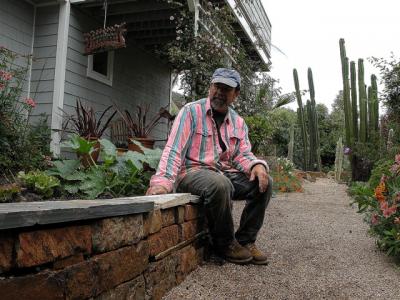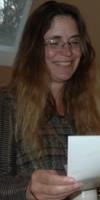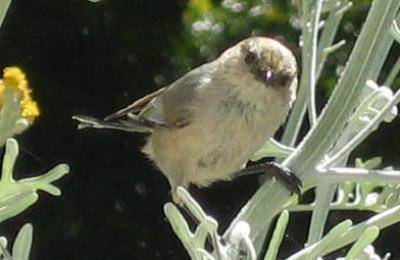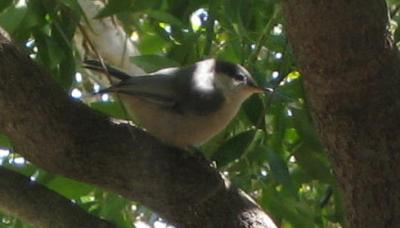Nice day at the breakwater.
all photos by June

Created by June Morrall
Murder in Montara: The Babes in the Woods Case 1946; Part V
There was a lot of back-and-forth over where Vorhes Newtonâs arraignment would take place in the summer of 1946. Who knows how they finally worked it out but those officials who pushed the Redwood City County Courthouse venue, lost, and it was decided the 24-year-old Newton would be arraigned on the Coastside where his horrific crime had been committed.
Half Moon Bay was a rural country village, and Judge Manuel Bettencourt, who presided over the court there, was the kind of man you either liked or hated, He was called âThe Judgeâ? and depending on who was saying it, âThe Judgeâ? sounded warm and friendly or tainted with a smoldering ire.
One thing nobody could deny, âThe Judgeâ? had broken social barriers by marrying the pert, outgoing Irene Debenedetti, the daughter of one of the most prominent families in town. She was Italian; he was Portuguese; theirs may have been the first such important marital union in Spanishtown, as the ârealâ? locals called Half Moon Bay.
It was only an arraignment, a legal procedure measured in minutes, but no matter how small his role âthe Judgeâ? would be a presence.
Judge Bettencourtâs office/courtroom stood on Main Street, across the way from today’s âOriginal Johnnyâsâ? coffee shop. Bettencourtâs courtroom was a space big enough to hold a maximum of 25 spectators.
Dubbed the âBabes in the Woodsâ? case by the press, Vorhes Newton had attracted national attention putting Redwood City, where the heavy legal business was conducted, on the map. This case could make reputations.
Due to all the attention, Judge Bettencourtâs Half Moon Bay courtroom couldn’t comfortably accommodate all the photographers, reporters, the curious, the locals and the participants. Sheriffâs deputies, with their prisoner, had to push through the crowd before a decision was made to move the whole show to the nearby high schoolâs gymnasium, accommodating 150 spectators. When the bleachers were full, chairs were quickly brought in and a courtroom improvised with tables from the classrooms.
Sheriff Walter Moore, member of a prominent Pescadero family, acted as bailiff. County District Attorney Gilbert Ferrell arrived with Fred Wyckoff, Ferrellâs second-in-command who had done most of the early case work.
The noise of onlookers didnât drown out official voices in the makeshift courtroom in the school gym– rather there was a stunned quiet– and, besides the normal curiosity associated with people wanting to see the kind of man who would murder his own children–there was pity for young Vorhes Newton.
Wearing a checkered sports jacket and brown tie, Vorhes had a scrubby brown beard, his face was bruised, his black eye colored a purplish hue now. His own personal trial had caused his shoulders to droop. When his eyes searched the school gym, he recognized half a dozen members of his family but Vorhes didn’t smile or nod at them. He still couldn’t believe he committed the murders.
Judge Bettencourt asked the defendant if Vorhes Newton was his name and he softly answered, âYesâ?.
Then followed a series of damning witnesses First was Fred Simmons, Half Moon Bayâs deputy sheriff. He spoke of bringing a bloodied Lorraine Newton to the Community Hospital. He told of finding the bodies of the two little ones.
John Kyne testified to finding the bodies of the two babies at the Montara flower ranch which was also confirmed by Kyneâs employees James Fiedler and Steve Torre,.
Mrs. Dodd, the Newtonâs Alameda neighbor, told the court that she accompanied the Newton family on the first part of the murder ride. She was dropped off at the Alameda navy base. Later that day she saw Vorhes return home alone.
Of interest to defense attorney Leo Friedman was Mrs. Doddâs statement that she often heard Vorhes call his wife, âBossâ?. In her opinion Lorraine Newton was the quarrelsome type, not her husband.
Witness Anthelmo Quaves said he saw an auto containing a man and woman drive slowly into the lonely canyon and heard yelling and the sounds of someone being beaten. He said he saw the auto come back speeding out of the canyon.
Lorraineâs mother, Mrs.Tuttle, said her daughter was improving and identified her engagement and wedding rings
Defense attorney Leo Friedman revealed that Mrs. Newton knew she was pregnant, wanted to confirm it with a doctor and left open an abortion.
Newton sat solemnly at a studentâs desk in the makeshift courtroom, obviously relieved when Deputy Sheriff Jack OâBrien escorted from out of the courtroom and back to the car that would return him to the Redwood City County Jail.
Outside the courtroom in Half Moon Bay, defense attorney Leo Friedman joked with reporters and photographers. They knew him from for his role in two sensational trials, that of Mrs. Frances Andrews and David Lamson.
Lorraine Newton did not make an appearance. So far she had remained in the background.
To be continued….
 Leon Kunke, artist and landscaper, sits on a rock wall near my veggie garden. Note “the desert” in the background–everybody says it’s amazing that cacti and succulents grow to such amazing size in El Granada!
Leon Kunke, artist and landscaper, sits on a rock wall near my veggie garden. Note “the desert” in the background–everybody says it’s amazing that cacti and succulents grow to such amazing size in El Granada!
Center: More Garden, rock walkway near the tropical part of the garden (there’s an unseen pond to the left)
Bottom: Leon created these textiles for me
If you like Leon’s work, call him at 650.599.9978
all photos by June
I do. And this new book is delicious, illustrated with lots of (in color) fabrics and textiles that inspired the great painter Matisse–and how he worked the fabrics into his art, the lusciously detailed paintings that cause you to linger and enjoy his visions. If you love Matisse, this book will make you swoon.
There isn’t just one author listed on the spine or the front of the book–in fact, there’s none. But inside it becomes clear that this was a collaborative effort by Kathleen Brunner and Ann Dumas, independent art historians, Jack Flam, Art History Professor at the Graduate School of NYU, Remi Labrusse, Contemporary Art History Professor, Universite de Picardie, Amiens, Hilary Spurling, Author of “The Unknown Matisse” and Dominique Szmusiak, Chief Curator of the Musee Matisse, Le Cateau-Cambresis.
I’m not one who favors collaborations, because they usually turn out to be an ugly mess. Many art experts worked on this new book about Matisse, his art and his textiles, and I must congratulate all of the authors because they have created a thing of beauty and I am grateful.
Deb Kessler writes “When we moved into the house, a neighbor told us a rumor she had heard that the house was built as a beach cottage for a silent film actress who lived in SF. I do not have any information to prove or disprove this rumor. The house is 1200 sq ft with 2 bedrooms and 1 bath. It is clearly boat-like in appearance and the upstairs room is very evocative of a room on a boat. Knotty pine walls and ceiling, a low ceiling–very warm and cozy.”
You can’t miss this unique house, built in 1929, on Carmel Avenue in El Granada.
Miss Kessler did a search of tax records at the County Government Center “and was able to work backward only to 1937 then got stymied.” She spent hours searching through “microfiche and huge leather-bound title records books”
She purchased the house from the Lelia Gilly family in 2001. “There were 9 or 10 kids in the family who grew up here, “Deb Kessler emailed me. ” I occassionally see Penny Gilly, one of the kids who grew up here, but she does not have old photos or historical information.”
Please email [email protected] if you have historical information about this unusual home.
Whether the San Mateo County District Attorney would press for the death penalty in the Vorhes Newton case was not yet known. Newtonâs was a heinous crime, the killer of his two little children who were left to die on a lonely road in Montaraâand the attempted murder of his young pregnant wife.
Luckily, 21-year-old=year Lorraine Newton had survied and was slowly recovering from severe head injuries in a Half Moon Bay hospital in the summer of 1946.
Lorraine hadnât been told that the babies were dead, and although she hadnât talked to her husband, the pair both agreed about one thing: neither remembered what happened at the end of that horrible day. Theyâd had an argument about abortion, they remembered that, but then both Lorraine and Vorhes maintained they blanked out and couldnât recall anything else.
The prosecutors had no trouble mapping out what had happened. They had an open and shut case, with testimony, evidence and the murder weapon in their possession, enough to convict and ask for the death penalty. The prosecution was anxious to go to trial, which they predicted would be short and sweet.
The prosecution team also bragged that they had damning testimony even if Newtonâs wife couldnât testifyâbut they believed she would be well enough to do so. They had the murder weapons, a sharp-edged shovel and a babyâs milk bottle.
Vorhes Newton was not a loner, not without the love and support of his wealthy family, his father an affluent farmer from nearby Lodi, and one of his brothers a successful âcoin phonographâ? operator. His parents and siblings rushed to his side at the county jail, strategizing with Leo Friedman, the nationally known and colorful attorney who replaced former superior judge Alden Ames, said to have had second thoughts about representing the controversial defendant.
Fresh from winning several tough cases for his clients, Leo Friedman huddled with Vorhes Newton’s family, discussing strategy. He walked away forty five minutes later telling the press Vorhes impressed him âas a lovely boy with a good record. I donât even know that he did it. If anybody did do anything like thisâhe must be crazy.â?
After the legal conference with Friedman, Newton followed his new lawyerâs advice and refused to give up any information during future grilling by detectivesâeven though he had already allegedly confessed bludgeoning the babies to death.
Friedman wanted that confession repudiated because it had been elicited under the duress of grilling. He mentioned the possibility of a plea of ânot guilty by reason of insanityâ?.
County District Attorney Gilbert Ferrell said that Mrs. Newton was pregnant but, when asked if she would keep the baby, he said no one had that answer– but that the pregnancy was certainly the cause of the argument between the couple and the violent events that followed. Vorhes and Lorraine Newton, Ferrell said, were arguing about the abortion, an illegal medical procedure in 1946. Ferrell did not reveal whether husband or wife was for or against it.
Medical experts believed the beating Lorraine received could lead to a miscarriage.
Her parents, residents of southern California, came to their daughterâs bedside. Lorraineâs father, Frank Tuttle, was the port auditor at Los Angeles. She had still not been told of her childrenâs deaths but was conscious and conversing with nurses at the Coastside hospital.
But would she appear as a witness at her husbandâs trial?
To be continued….
Special to Half Moon Bay Memories & El Granada Observer

December Birds in El Granada
by Cherie Dailey
Three years ago my novice interest in birds was over indulged. My Christmas gifts included bird books, feeders, nesting materials, and a beautiful bird bath. I am still a novice, but I can identify all the birds in my yard by sight and most of them by sound. Iâve collected a treasure of special bird stories to share with anyone that even hints at an interest in birds. In a nutshell, Iâve gone to the birds.
One of the aspects of birding that Iâm well aware of now is the fact that if you pay attention, they pronounce the seasons as clearly as the weather. So as we march into wintertime, I can confirm the season as I watch and listen to the birds.
Fall is heralded by the Golden Crown Sparrow. Their song is a child hood memory for meâ¦â?Oh Dear Meâ? – they stay until springtime. The Golden Crown and the White Crowns are a winter staple in the backyard. They join the year round residents: Hummingbirds, American Goldfinch, Towhees, House Finch, Pygmy Nuthatch, Bushtit, Chickadee, Common Sparrow, Mourning Dove, Black Phoebe, Robin, the occasional Stellar Jay, and, my least favorites, the Brewerâs Blackbird and the English Starlings.
Photo at left:  The Bushtit is Cherie’s longtime companion, Peter Logan’s favorite fuzzy bird in the garden.
The Bushtit is Cherie’s longtime companion, Peter Logan’s favorite fuzzy bird in the garden.
The Fox Sparrows are a current favorite of mine that also hang out during the winter. There are only a few of them in the yard. They are distinct against the dozens of other types that visit our feeders with their speckled breast and bold behavior (Sparrows like to feed off the ground under the feeders â they donât actually get onto the feeders often). One of our current residents is a Townsend Warbler. He is a colorful contribution to the duller colors the birds sport in the winter. Heâs not a seed eater, so heâs especially welcome to eat the insects that collect around the yard.
There is one aspect of attracting the songbirds to our yard that we had not counted on. We have our annual winter visits from a Sharp Shinned Hawk. âSharpiesâ? are Accipiter hawksâ¦that means they eat birds. Weâve had some wild events in our backyard since the hawk has put us on his winter menu. Itâs pretty easy to determine when heâs on the prowl â there are no birds to be seen anywhere in our yard, or worse, we see the pile of feathers he/she leaves behind. Nature is known for her drama. Fortunately, they move on early in the springtime so we can enjoy the nesting season.
Our most unique winter sighting was a Red Poll. This is an arctic bird that somehow got off track. It was by pure luck that we identified him correctly, but it was a sure sighting. A âfeatherâ? in our birding cap.
All in all, birding may sound dull if you havenât stopped to really listen. What a wonderful world we have right here in our backyards. You can hear a hummingbird quite easily, chickadees and sparrowsâ¦the list goes on. And, like I said, if you show even a hint of interest, I have some really colorful tales to tell of the birds in my yard in El Granada
 The delicately beautiful Nuthatch rests on a branch in Cherie and Peter’s meditative garden in sunny El Granada.
The delicately beautiful Nuthatch rests on a branch in Cherie and Peter’s meditative garden in sunny El Granada.
Bird photos by Cherie Dailey
Photo of Cherie Dailey by June